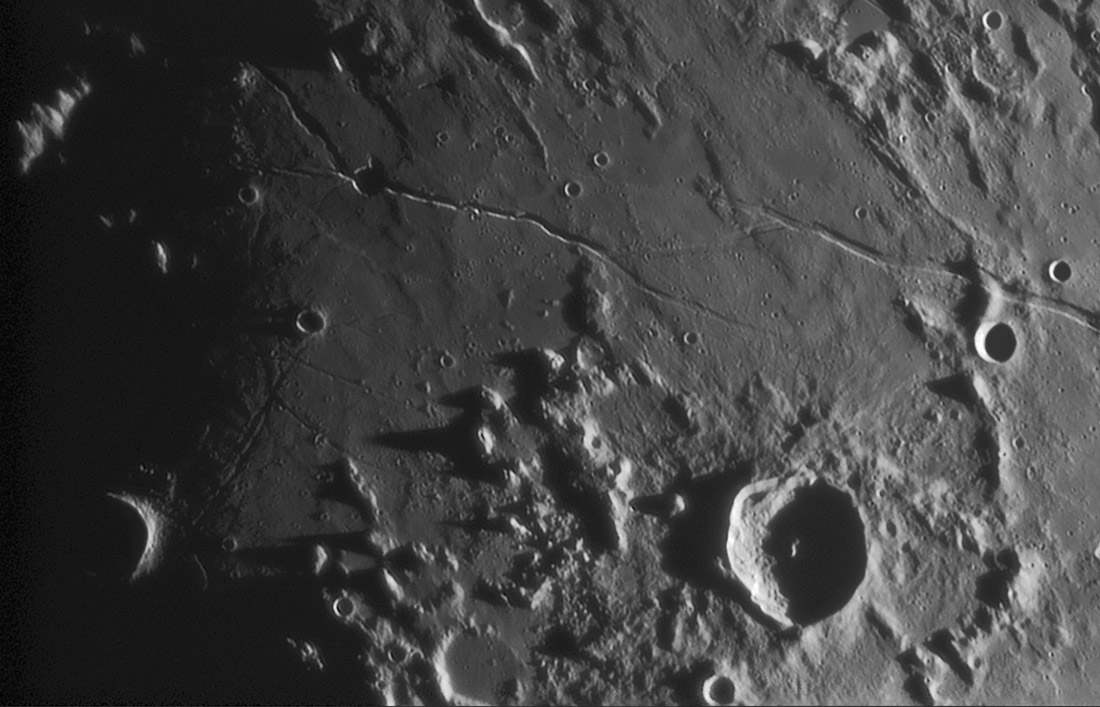LPOD Mar 3, 2008
TRIPLE JUNCTION

image by Stefan Lammel
Three of the Moon's most famous rille systems come together in this excerpt of a new low-Sun mosaic from Stefan. Shadows shroud Triesnecker at bottom left but some of its narrow rilles with a rectilinear pattern point north toward rimless Hyginus and its famous clock-hand rilles. And just where the eastern end of the Hyginus Rille becomes shallow, an even weaker branch of the Ariadaeus Rille connects with it. No one understands the relationships between these rille families, but because some parts of them are roughly radial to the Imbrium Basin it seems likely that the basin somehow influenced them. Stefan's dramatic image shows rilles previously seen or discovered in views by François Emond and Wes Higgins. One rille seems to be newly seen here and that is a very faint westward extension of the end of the Ariadaeus Rille. The rille is well-defined with parallel sides - one casting narrow shadows and the other a bright line of light - where it crosses some textured Imbrium ejecta. But just where the rille reaches lower terrain covered with smooth material (lava?) it disappears and is only hinted at for another 50 km. If you are having trouble finding the rille it passes between the small craters Hyginus F and C, north of the Hyginus Rille. The putative rille extension is a boundary - to its north is the smooth mare material, but the terrain to the south is slightly brighter and slightly rougher. A full Moon view shows that the smooth material is dark and thus is real mare material. The slightly brighter material was mapped by the US Geological Survey as Cayley Formation, which was ultimately interpreted as basin ejecta. The mare material is younger than the Cayley, thus covering the Ariadaeus Rille, with only a few hints of the rille's existence, The mare patch north of the rille is so distinctive that it was given a designation - Hyginus Z. Stefan's image reveals a 10 km wide dome with two tiny near-summit pits on the north side of Z.
Chuck Wood
Technical Details
13-Feb-08 18:08UT. 10in f4.8 Newtonian + Infinity 2-1M
Related Links
Rükl plate 34
SOMETHING NEW!
To post comments regarding this LPOD, please click here and enter your text just below the word "Comments". Perhaps if comments are more visible, there will be more of them! You will not see the Edit tab unless you register for the wiki. Please do not edit the LPOD itself!
COMMENTS
(1) I think it's worth noting that in addition to using the right telescope and photo equipment, getting an image like this of the waxing Moon requires planning and good timing. I believe the terminator moves at about 12 mph, so there is just a relatively brief period when the combination of light and shadow is just right to illustrate rilles and other features. Stefan's images do not happen by accident. Good work!
When you think about it, there are literally thousands of images that can be taken at different magnifications all along the terminator, from top to bottom, as it moves across the face of the Moon. And the angle of light can come either from the rising sun or setting sun as the Moon waxes and wanes moment by moment.
--Bill